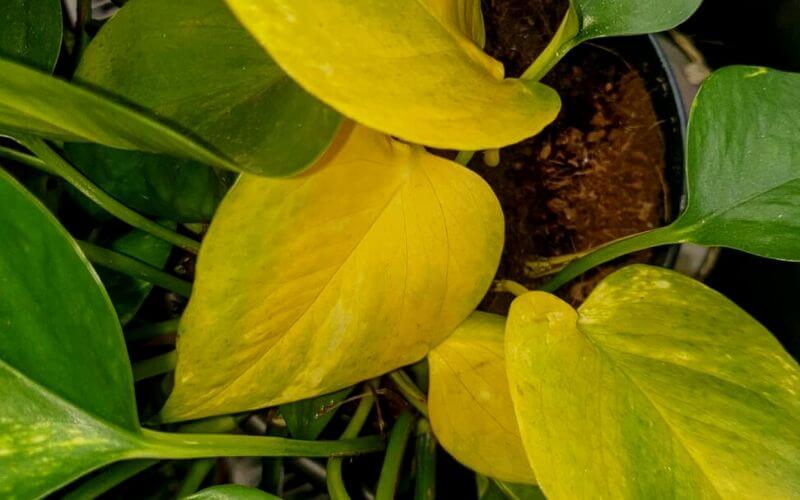Perplexed by your indoor pothos yellow leaves?. You cannot help it but try to solve the seemingly impossible puzzle highlighted by the question, “Why are my pothos leaves turning yellow?”. Look no further; in this post, I shall show you how you can quickly and systemically pinpoint the problem. This will require you to unleash your inner Sherlock Holmes investigative ingenuity.
For each problem, you will find remedial tips in order to halt more leaves turning yellow. Before you switch on to panic mode, the yellowing of your beloved plant’s leaves is no death sentence by any means. Scroll down and see how to distinguish real problematic yellowing from yellowing triggered by natural causes.
Reasons For Pothos Leaves Turning Yellow And Their Remedies

1. Lack of adequate nutrients
In general, the yellowing of leaves in any plant is associated with a lack of essential nutrients like nitrogen. Nitrogen’s role infauna is to promote the growth and development of the plant. Thus in its absence, the obvious result will be stunted growth or death of the plant in the worst scenario.
Firstly try to investigate the nature of your pothos plant soil. If there is a fair share of organic content that you can visually identify by the color black, then lack of nitrogen is not the problem. However, if it happens to be the culprit, then take the following corrective measure:
Solution: Add fertilizer to your pothos plant
Apply nitrogenous inorganic fertilizers like ammonium nitrate to the soil. However, be wary about adding too much of it as this has counter corrective results. You will usually find instructions on the quantity you can apply from the manufacturer, so just abide by these. Organic fertilizers are equally as good, so you might want to try them too. Also, try using fertilizers that contain calcium or boron.
2. Exposure To Too Much Direct Sunlight
Pothos plants are well suited for the indoor environment, and they require moderate sunlight. However, do not have your plant situated directly on that spot, basking in abundant sunlight. This is a red alarm. The potho yellow leaves result from the sun’s direct scotching. As a corrective measure, perform this simple tip :
Solution: Remove Pothos Plant from Direct Sunlight
By simply removing your plant and placing it where there happens to be moderate light, you effectively solve it. Pothos plants being indoor plants, will still flourish in areas with low sunlight, so do not overthink it.
3. Too Much Moisture
This happens to be the most common reason to have your pothos leaves turning yellow. Too much moisture tends to leach out nutrients like nitrates. Additionally, it promotes severe problems like root rot, which can destroy the whole pothos plant. Always check and investigate the level of moisture your soil is holding.
If it happens to be above normal like soggy wet, then you have found yourself the cause. In this case, you are likely to observe yellow leaves that are fading to a bright yellow. More so, the base of the pothos plant may become blackened due to rotting. Carry out the following tip with consistence as a preventative measure:
Solution: Only Water When The Soil Is Dry
As a rule of thumb, only water when the top 25% of the pot’s soil is dry. Use your fingers or stick to check how moist the ground beneath is. In winter, make an exception and go ahead and allow your plant to dry a little more between watering. However, it is also wise to sometimes carry out regular misting to boost humidity around the plant.
Also, ensure that you have provided adequate drainage on the plant’s pot so that the excess will get drained out when your water. Note that alternating between bone dry and wet soil from ill-timed watering can create stress and cause your pothos’ leaves to yellow.
4. Insufficient Watering
Too little water cause wilting of the plant, leading to the death of leaves marked by yellowing. If you notice that the other three previously mentioned problems are not responsible, this is likely. Additionally, you will see yellow leaves that have curled inward and are dropping or crisping. Lack of sufficient water results in the plant’s inability to extract the soil’s nutrients, ultimately leading to an unhealthy plant and leaves’ yellowing. The obvious solution to this is:
Solution: Sufficiently Water Your Plants
Make sure your plants are always watered well. Hot outdoor conditions influence the indoor air conditions, so it is essential to keep an eye on the state of your plant’s soil. See if you can easily sink your finger or deep a stick into the soil and also have a feel of the ground to see if it is bone dry. Carry out misting around the plant to boost humidity when air is dry.
5. Spider Mites
These tiny yet wreckful creatures are catastrophic to many plants. Adding salt to the wound becomes a task trying to identify them due to their miniature size. For successfully scouting your plant for a mite infestation, you will need to use a magnifying glass. Once they have infested your pothos plants, the leaves’ yellowing will follow suit together with sustained deformities. As a corrective measure, carry out the following tip:
Solution: Apply chemicals to kill the mites
Although you can apply homemade chemicals like insecticidal soap on the leaves, it is less effective if done only once. Mites are fast breeders and survivors, so the best corrective measure is to use inorganic pesticides. This will put an end to the mite problem once and for all. Additionally, remove those leaves that fall out on the pot’s soil and discard them.
6. Too Much Cold Or Hot Temperatures
Your pothos plants will do well when exposed to high temperatures in the range 70-90 degrees Fahrenheit. Higher temperatures denature the plant’s leaves, thereby triggering their yellowing. They can still manage to thrive in lower temperatures, not exceeding 50degrees Fahrenheit.
Temperatures lower than the 50 degrees Fahrenheit efficiently inhibit leaf cellular growth ending up killing them from frostbite. If you observe more of a pale yellow or whitish-yellow with or without dropping leaves, temperature effects are responsible. As a corrective measure, use the upcoming tip.
Solution: Place Your Plant Were Temperatures Are Just Right
You must monitor your indoor temperature using a thermometer. Use artificial heating or cooling to maintain room temperatures.
7.Fungi Related Infections
These organisms cause root rot, therefore, depriving your plant of essential nutrients. In turn, this causes yellowing of your pothos plant leaves, and you might observe some fungus gnats. Fungus thrives in very wet conditions when the temperatures are warm. Carefully inspecting your plant for any rotting will determine if fungi are responsible. Do the following corrective and preventative measures:
Solution: Transplant Your Plant And Add Fungicides.
Carefully remove your plant from the infected soil, and apply Sulphur based fungicides where there is root rot. Replace the plant in a pot with sterilized soil. As a preventative precaution, avoid watering while your plants’ soil is still wet. Only do so when it is significantly dry. More so, avoid unnecessary misting because fungus thrives in high humidity.
8.General Malaise
A “general malaise” of a plant turning chartreuse implies that your pothos plant is pot-bound such that the roots have no room to expand. The effects of this are marked by the leaves and the rest of the pothos plant semi-yellowing, though without dropping leaves. A corrective measure you need to reverse the effects is as follows:
Solution: Repot To A Bigger Pot
Carefully transplant your pothos plant to a bigger pot, one which will allow for root expansion for some time. Also, apply fertilizer on completion of this feat to stimulate the root development in the bigger pot.
9. The Plant Is Still Getting Acclimated
Humans are the only ones who take some time to get used to newer environments. Plants experiencing a change of environment are also known to react by exhibiting yellow leaves. Try out the following remedy as to a corrective measure:
Solution: Ensure Plant Has Sufficient Light
Make sure that your plant receives adequate light. Also, try to use a mister on the pant and apply a weak micronutrient solution to help revive and relieve stress.
10. Natural Yellowing In Response To Growth
Sometimes yellowing of pothos leaves is a result of natural processes that are not problematic to your plant. Older pothos leaves at some point turn yellow or even fall off to allow for new ones to grow. Thus before you panic, make sure you examine all the previous causes, of which ruling them out indicates natural yellowing.
What To Do If Pothos Leaves Turning Yellow!
With this, I put to rest the question, “Why my pothos leaves are turning yellow?”. Pothos plants are well suited indoor plants, and you just have to give them extra care like a baby. It is also in your best interest to avoid expending your energy panicking once you observe leaves yellowing. Instead, apply the best corrective measures by first investigating what would be likely causing the yellowing. Attacking the problem while “in the dark” is like looking for the tiniest needle in a haystack. Thus with the proper application of the tips I have provided, you should have yourself a healthy growing pothos plant.

Leave a Reply